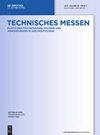Machine learning approach for impedance locus uncertainties
IF 0.7
4区 工程技术
Q4 INSTRUMENTS & INSTRUMENTATION
引用次数: 0
Abstract
Abstract This work deals with the determination of the uncertainty of measurement data, determined by electrical impedance spectroscopy. Four different types of sand were measured impedimetrically in a measuring cell designed as a plate capacitor in a frequency range from 20 Hz to 1 MHz. The measuring cell was filled ten times with each sand and 20 impedance spectra were recorded for each filling. The uncertainty at each frequency was determined from the measurement data. It was found that the measurement data variance with a given measuring-cell filling was negligibly small. However, it increased by a factor of up to 100 when the measuring cell was repeatedly emptied and re-filled with the same material. We propose a way to estimate a continuous approximation of the uncertainty band of the impedance locus in the complex plane from the discrete uncertainties at each frequency. It uses a Support Vector Machine (SVM) to generate a regression curve using the discrete uncertainties. The result of the regression was used to estimate the uncertainties of an average impedance locus. The said machine learning tool can handle large amounts of data, classes, and influencing variables. In this manner, it can help to identify cause-effect relationships. Furthermore, at the end of this work a possibility to estimate a continuous uncertainty band along the impedance locus curve via SVM regression is shown. This is an extension to the common methodology in literature, where the uncertainty is only determined at selected individual points of the impedance spectrum.阻抗轨迹不确定性的机器学习方法
摘要本文讨论了用电阻抗谱法确定测量数据不确定度的方法。在一个设计为平板电容器的测量单元中,在20 Hz到1 MHz的频率范围内对四种不同类型的沙子进行了阻抗测量。每种砂填充10次,每次填充记录20个阻抗谱。每个频率的不确定度由测量数据确定。结果表明,在给定的测量单元填充情况下,测量数据的方差可以忽略不计。然而,当测量单元反复清空并重新填充相同的材料时,它增加了高达100倍的系数。我们提出了一种从每个频率上的离散不确定性估计复平面阻抗轨迹不确定性带的连续逼近的方法。它使用支持向量机(SVM)利用离散不确定性生成回归曲线。回归结果用于估计平均阻抗轨迹的不确定性。上述机器学习工具可以处理大量数据、类和影响变量。通过这种方式,它可以帮助识别因果关系。此外,在本工作的最后,展示了通过支持向量机回归沿阻抗轨迹曲线估计连续不确定性带的可能性。这是文献中常见方法的延伸,其中不确定性仅在阻抗谱的选定单个点上确定。
本文章由计算机程序翻译,如有差异,请以英文原文为准。
求助全文
约1分钟内获得全文
求助全文
来源期刊

Tm-Technisches Messen
工程技术-仪器仪表
CiteScore
1.70
自引率
20.00%
发文量
105
审稿时长
6-12 weeks
期刊介绍:
The journal promotes dialogue between the developers of application-oriented sensors, measurement systems, and measurement methods and the manufacturers and measurement technologists who use them.
Topics
The manufacture and characteristics of new sensors for measurement technology in the industrial sector
New measurement methods
Hardware and software based processing and analysis of measurement signals to obtain measurement values
The outcomes of employing new measurement systems and methods.
 求助内容:
求助内容: 应助结果提醒方式:
应助结果提醒方式:


